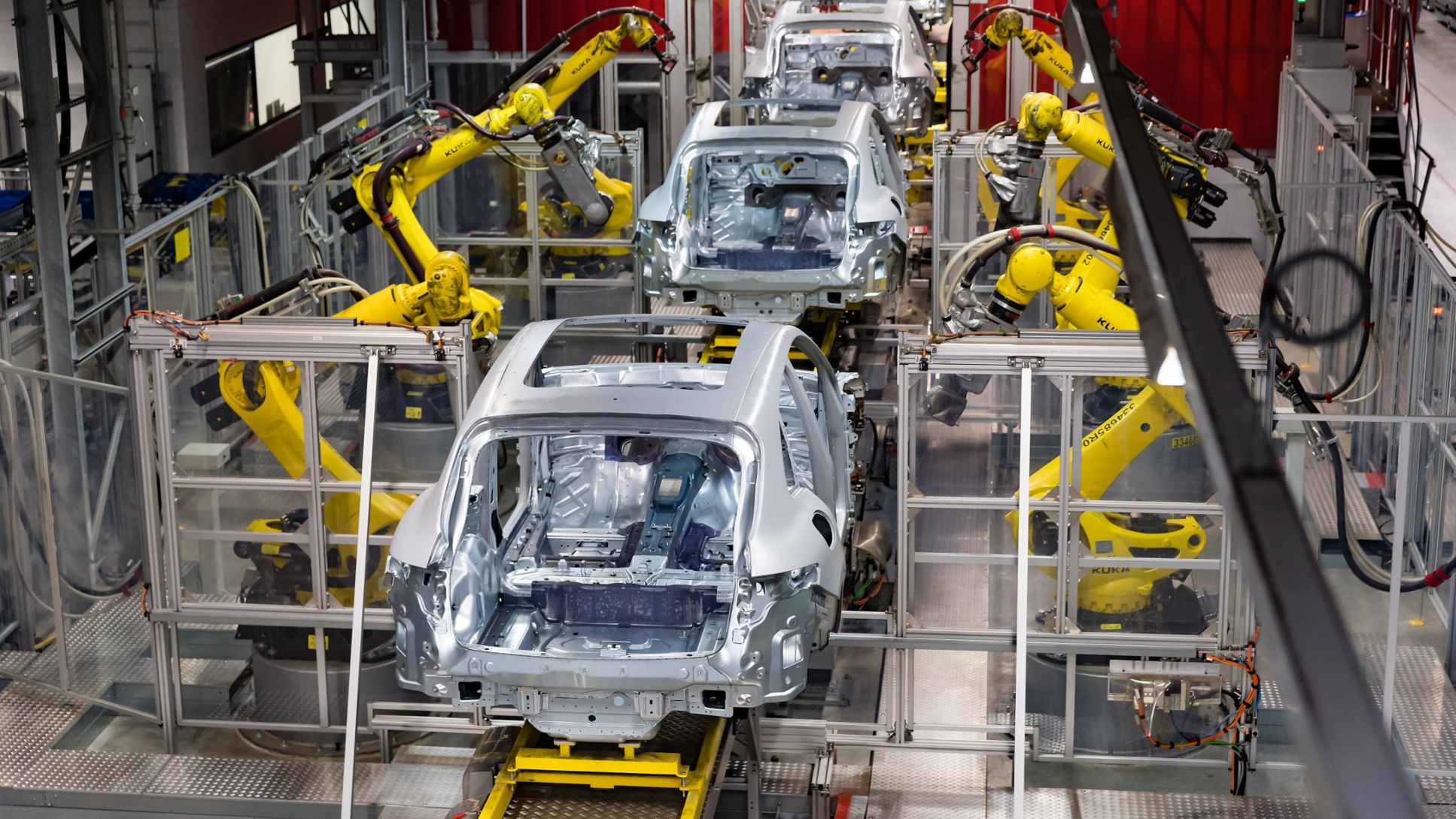
The Porsche 911 is a legendary sports car that has captured the hearts and minds of car enthusiasts around the world. Known for its iconic design and impressive performance, the Porsche 911 is a true symbol of automotive excellence. But have you ever wondered how this masterpiece of engineering is made?
Every Porsche 911 starts its journey in the manufacturing plant, where skilled craftsmen and cutting-edge technology come together to bring the vision of the designers to life. The manufacturing process of the Porsche 911 is a meticulously crafted ballet, where every step is carefully planned and executed to ensure the highest quality standards.
From the moment the raw materials arrive at the factory, to the final assembly and testing, each Porsche 911 goes through a series of precise and rigorous processes. The body of the car is carefully crafted using a combination of lightweight materials, such as aluminum and high-strength steel, to ensure optimal performance and safety.
Once the body is completed, it goes through a series of painting and finishing processes, where it is meticulously inspected for any imperfections. Skilled technicians hand-assemble the engine, transmission, suspension, and other components, ensuring that each part fits perfectly and functions flawlessly.
Finally, every Porsche 911 undergoes a rigorous testing process to ensure that it meets the highest standards of performance and quality. From acceleration and braking tests, to handling and endurance tests, each car is put through its paces to ensure that it delivers the exhilarating driving experience that Porsche is known for.
In conclusion, the manufacturing process of the Porsche 911 is a testament to the dedication and passion of the craftsmen and engineers who bring this iconic sports car to life. From the careful selection of materials, to the precision assembly and testing, every step is taken to ensure that each Porsche 911 is a masterpiece of engineering and design.
Designing the Porsche 911
The design of the Porsche 911 is a result of decades of refinement and evolution. The iconic shape of the 911 has remained largely unchanged since its introduction in 1963, with subtle updates and improvements made over the years. The design team at Porsche is dedicated to creating a car that not only looks stunning, but also performs at the highest level.
The process of designing the Porsche 911 begins with extensive research and development. The team analyzes market trends, customer preferences, and technological advancements to ensure that the car is on the cutting edge of design and innovation. They also draw inspiration from the rich history of the 911, incorporating elements from previous generations to maintain the car’s timeless appeal.
Once the initial design concept is established, the team moves on to creating detailed sketches and 3D models. These designs are carefully reviewed and refined to ensure that every line and curve contributes to the overall aesthetics and performance of the car. The team pays careful attention to aerodynamics, weight distribution, and ergonomics to create a car that is not only beautiful, but also efficient and comfortable to drive.
The design process also involves collaboration with engineers and production experts to ensure that the car can be manufactured within budget and on schedule. The team considers factors such as materials, manufacturing techniques, and assembly processes to optimize production efficiency without compromising quality.
Overall, designing the Porsche 911 is a meticulous and collaborative process that combines artistry, engineering, and innovation. The result is a car that embodies the Porsche brand’s commitment to excellence and continues to captivate car enthusiasts around the world.
Incorporating Aerodynamics and Performance
The Porsche 911 is known for its sleek and aerodynamic design, which is a result of careful engineering and attention to detail. The car’s body is designed to reduce drag and improve overall performance.
One of the key features that contribute to the aerodynamics of the Porsche 911 is its rear spoiler. The spoiler is adjustable and automatically deploys at high speeds to increase downforce, providing better stability and grip on the road. This helps the car maintain control and enhances its overall performance.
Another important aspect of the Porsche 911’s aerodynamics is the design of its air intakes and vents. These are strategically placed to optimize airflow and cooling, ensuring that the engine and brakes stay at optimal temperatures during high-speed driving. This not only improves the car’s performance but also reduces the risk of overheating and mechanical failures.
The Porsche 911 also incorporates lightweight materials, such as aluminum and carbon fiber, in its construction. These materials are not only strong and durable but also help reduce the car’s overall weight. This, in turn, improves fuel efficiency and agility, allowing the car to accelerate and maneuver more efficiently.
Furthermore, the Porsche 911’s suspension system is designed to enhance its performance on the road. The car features a sport-tuned suspension with adjustable settings, allowing drivers to customize the car’s handling and ride comfort to their liking. This, combined with the car’s aerodynamic design, ensures that the Porsche 911 delivers an exhilarating driving experience.
Creating the Iconic Exterior

The iconic exterior of the Porsche 911 is meticulously crafted through a series of precise manufacturing processes. Each step is carefully executed to ensure that the final product embodies the timeless design and high-performance capabilities that the 911 is known for.
One of the first steps in creating the exterior of the 911 is the body shell construction. The body shell is made from a combination of lightweight materials, such as aluminum and high-strength steel, which provide both durability and agility. The components are carefully welded together using advanced robotic technology to ensure precise and consistent results.
Once the body shell is complete, it undergoes a series of surface treatments to enhance its appearance and protect it from corrosion. This includes a thorough cleaning process to remove any contaminants, followed by several layers of primer and paint. The paint is meticulously applied, with each layer carefully inspected to ensure a flawless finish.
The exterior design of the 911 is further enhanced through the use of aerodynamic features. These features, such as the rear spoiler and side air intakes, are carefully designed and integrated into the body to improve stability and reduce drag. The shape of the body itself is also meticulously sculpted to optimize airflow and improve performance.
Finally, the finishing touches are applied to the exterior of the 911. This includes the installation of the iconic Porsche badging and the fitting of the distinctive headlights and taillights. The final product is then thoroughly inspected to ensure that every detail meets the high standards set by Porsche.
Overall, the process of creating the iconic exterior of the Porsche 911 is a labor of love. From the body shell construction to the final finishing touches, every step is carefully executed to create a masterpiece of design and engineering.
Crafting the Luxurious Interior
The Porsche 911 is renowned for its luxurious interior, which is meticulously crafted to provide the ultimate driving experience. From the moment you step inside, you are greeted with a combination of premium materials, exquisite craftsmanship, and cutting-edge technology.
One of the first steps in creating the luxurious interior of the Porsche 911 is the selection of high-quality materials. The finest leather hides are carefully chosen and inspected for any imperfections. These hides are then meticulously cut and stitched by skilled artisans to create the seats, dashboard, and other interior components.
In addition to leather, the interior of the Porsche 911 features a variety of other premium materials, such as wood, aluminum, and carbon fiber. These materials are carefully selected and integrated into the design to create a harmonious and visually stunning interior.
The craftsmanship that goes into the interior of the Porsche 911 is truly remarkable. Every stitch, every seam, and every detail is meticulously executed to ensure perfection. Skilled artisans work tirelessly to create a cabin that exudes elegance and sophistication.
Not only is the Porsche 911’s interior visually stunning, but it is also equipped with the latest technology. Advanced infotainment systems, state-of-the-art audio systems, and driver assistance features are seamlessly integrated into the interior, providing a truly immersive and connected driving experience.
In conclusion, crafting the luxurious interior of the Porsche 911 is a labor of love. From the selection of premium materials to the meticulous craftsmanship, every aspect is carefully considered to create an interior that is not only visually stunning but also provides the utmost comfort and functionality.
Engineering and Production

The engineering and production process of the Porsche 911 is a precise and meticulous one. It begins with the design phase, where engineers work closely with designers to create a blueprint for the car. This blueprint includes all the necessary dimensions, specifications, and features that will make up the final product.
Once the design is finalized, the production phase begins. This involves the sourcing of high-quality materials that will be used in the construction of the Porsche 911. The materials used are carefully selected to ensure that they meet the strict standards set by Porsche.
During the production process, the body of the Porsche 911 is carefully crafted. This involves the use of advanced machinery and techniques to shape and form the metal into the desired shape. The body panels are then carefully joined together to create a seamless exterior.
In addition to the body, the interior of the Porsche 911 is also meticulously crafted. This involves the careful selection and placement of high-quality materials such as leather, aluminum, and carbon fiber. The interior is designed to be both luxurious and functional, with every detail meticulously planned and executed.
Once the body and interior are complete, the Porsche 911 goes through a series of rigorous quality control checks to ensure that it meets the highest standards. These checks include tests for performance, safety, and durability. Any issues or defects are addressed and corrected before the car is deemed ready for production.
Overall, the engineering and production process of the Porsche 911 is a testament to the dedication and craftsmanship of the team behind it. From the design phase to the final product, every step is carefully executed to ensure that the Porsche 911 is a true masterpiece of automotive engineering.
Utilizing Advanced Materials and Technology

In the manufacturing process of the Porsche 911, advanced materials and technology play a vital role in ensuring the high quality and performance of the iconic sports car. The use of lightweight materials, such as aluminum and carbon fiber, helps to reduce the overall weight of the vehicle, improving fuel efficiency and handling.
Advanced manufacturing techniques, such as computer-aided design (CAD) and computer numerical control (CNC) machining, enable precise and efficient production of the Porsche 911 components. CAD software allows engineers to create detailed 3D models of the car, which are then used to guide the CNC machines in cutting and shaping various parts.
One of the key advancements in the manufacturing process is the use of robotic automation. Robots are employed for tasks such as welding, painting, and assembly, ensuring consistent quality and precision. These robots can perform complex movements with high accuracy, resulting in perfectly welded seams and flawlessly painted surfaces.
In addition to the use of advanced materials and technology, the Porsche 911 also undergoes rigorous testing and quality control processes. Each car is subjected to extensive performance and safety tests to ensure that it meets the brand’s high standards. This includes testing the engine, suspension, brakes, and various electronic systems.
The combination of advanced materials, technology, and meticulous craftsmanship is what makes the Porsche 911 one of the most revered sports cars in the world. From its lightweight construction to its precise engineering, every aspect of the manufacturing process is dedicated to delivering an exceptional driving experience.
Building the Engine and Powertrain
The engine and powertrain are critical components of the Porsche 911, providing the car with its impressive performance and driving experience. The engine is carefully assembled by highly skilled technicians at the Porsche factory, who meticulously follow a precise process to ensure the highest level of quality.
First, the engine block is carefully machined to precise specifications. This involves milling, drilling, and honing the metal to create the necessary surfaces and dimensions. Once the block is ready, the pistons, connecting rods, and crankshaft are installed. Each component is carefully inspected and measured to ensure a perfect fit.
The cylinder heads are then attached to the engine block, and the camshafts are installed. This is a critical step, as the camshafts control the valves and timing of the engine. They must be precisely aligned and synchronized for optimal performance.
Next, the fuel injectors, intake manifold, and exhaust system are installed. These components are designed to maximize the engine’s power output and efficiency. The fuel injectors deliver the precise amount of fuel to the combustion chambers, while the intake manifold ensures a steady flow of air. The exhaust system helps to optimize engine performance and produces the distinctive Porsche 911 sound.
The engine and powertrain are then thoroughly tested to ensure they meet the strict quality standards of Porsche. This includes testing for power output, durability, and emissions. Any issues or discrepancies are immediately addressed to ensure the engine performs flawlessly.
Once the engine is complete, it is carefully installed into the 911 chassis, along with the transmission and other powertrain components. This is a precise and meticulous process, as each component must be properly aligned and secured. Once installed, the engine and powertrain undergo final testing to ensure they are functioning perfectly before the car is ready for delivery.
Assembling the Chassis and Suspension

The assembly of the Porsche 911 chassis and suspension is a meticulous process that requires precision and expertise. It begins with the positioning of the chassis on a sturdy frame, ensuring it is securely in place. The suspension components, including the control arms, springs, and dampers, are then installed on the chassis.
The control arms, which connect the suspension to the chassis, are carefully aligned and bolted into place to ensure proper suspension geometry. The springs, which provide support and absorb shocks, are installed next. The dampers, or shock absorbers, are responsible for controlling the movement of the suspension and are attached to the control arms and chassis.
Once the suspension components are in place, the next step is to install the braking system. This includes the brake calipers, rotors, and pads. The brake calipers, which house the brake pads, are mounted on the suspension components, while the rotors are secured to the hub. The brake pads are then inserted into the calipers.
After the suspension and braking systems are assembled, the steering system is installed. This includes components such as the steering rack, tie rods, and steering column. These components are carefully aligned and connected to ensure smooth and precise steering.
Finally, the wheels and tires are mounted onto the hubs. The lug nuts are tightened to the specified torque to ensure the wheels are securely attached. The tire pressure is then checked to ensure it meets the manufacturer’s recommendations.
The assembly of the chassis and suspension is a crucial step in the manufacturing process of the Porsche 911. It requires attention to detail and adherence to strict quality control standards to ensure the final product meets the high-performance standards that Porsche is known for.
Quality Control and Testing
Ensuring the highest level of quality is a top priority in the manufacturing process of the Porsche 911. Quality control measures are implemented at every stage, from the sourcing of materials to the final assembly of the vehicle.
One key aspect of quality control is the thorough testing that each Porsche 911 undergoes before it leaves the factory. This testing includes both mechanical and performance testing, as well as rigorous inspections to ensure that all components meet the required standards.
During the mechanical testing phase, each Porsche 911 is subjected to a series of tests to evaluate its engine performance, braking system, suspension, and other mechanical components. This helps to identify any potential issues or defects that may need to be addressed before the vehicle is deemed ready for final assembly.
The performance testing of the Porsche 911 involves rigorous road testing under various conditions. This includes testing the acceleration, top speed, handling, and stability of the vehicle. These tests are crucial to ensuring that the Porsche 911 delivers the exceptional driving experience that it is known for.
In addition to mechanical and performance testing, the Porsche 911 also undergoes extensive inspections to check for any cosmetic or aesthetic defects. This includes checking the paint finish, the fit and alignment of body panels, and the overall interior and exterior quality of the vehicle.
To further enhance the quality control process, Porsche utilizes advanced technologies such as laser scanning and 3D imaging to detect and rectify any potential issues. These technologies allow for precise measurements and inspections, ensuring that each Porsche 911 meets the highest standards of craftsmanship and quality.
Overall, the quality control and testing measures implemented in the manufacturing process of the Porsche 911 are a testament to the commitment to excellence and the pursuit of perfection that defines the brand. From the sourcing of materials to the final inspections, every step is meticulously executed to ensure that each Porsche 911 that rolls off the production line is a true masterpiece of engineering and design.






